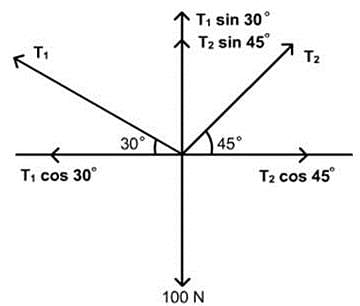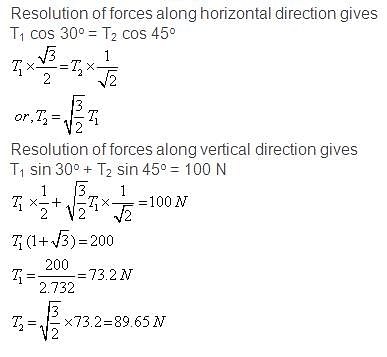Test: Common Forces in Mechanics - NEET MCQ
20 Questions MCQ Test Topic-wise MCQ Tests for NEET - Test: Common Forces in Mechanics
A train is moving along a horizontal track. A pendulum suspended from the roof of the train makes an angle of 5° with the vertical. The acceleration of the train is
A body of weight 100 N is suspended with the help of strings as shown in figure.

| 1 Crore+ students have signed up on EduRev. Have you? Download the App |
For a body along the inclined plane, the normal reaction acts
Two forces F1 and F2 are acting on a particle. The particle will remain at rest if two forces are
If no resultant force acts on a body then the body will be in
In mechanics, if the net external force on the particle is zero, then the particle is said to be in state of
A book is lying on the table. What is the angle between the action of the book on the table and reaction of table on the book?
A mass of 6 kg is suspended by a rope of length 2 m from a ceiling. A force of 50 N in the horizontal direction is applied at the mid-point of the rope, as shown. What is the angle the rope makes with the vertical in equilibrium?
Which of the conditions shows that the particles are in equilibrium state for two forces F1 and F2 acting on the body?
Which of the following forces is not considered as a contact force in Mechanics?
The contact forces of mechanics are fundamentally derived from
The minimum angle that an inclined plane makes with the horizontal when a body placed on it just begins to slide down is called
The forces F1, F2, and F3 are acting on a particle of mass m, such that F2 and F3are mutually perpendicular and under the effect of F1, F2, and F3 , the particle remains stationary. What will be the acceleration of the particle, if the force F1 is removed?
Tension on an almost massless rope being pulled by two boys, one small and one big, will be
Which of the following cannot be regarded as yet another kind of force?
The component of contact force normal to the surfaces in contact is called
|
9 docs|1272 tests
|




















